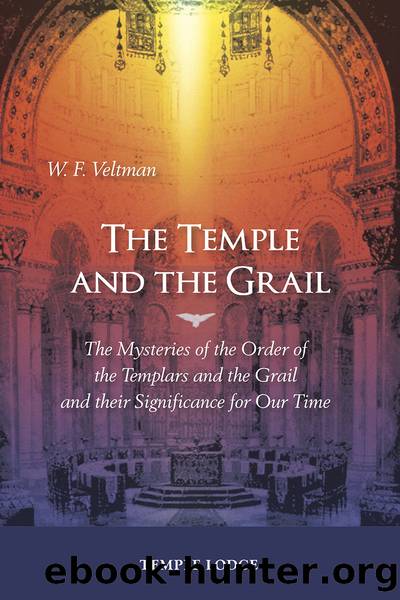The Temple and the Grail: The Mysteries of the Order of the Templars and the Grail and Their Significance for Our Time by W. F. Veltman

Author:W. F. Veltman [Veltman, W. F.]
Language: eng
Format: epub
Tags: Body; Mind & Spirit, New Thought, General, Religion, Theosophy, Spirituality
ISBN: 9781912230792
Google: h7UxEAAAQBAJ
Publisher: Temple Lodge Publishing
Published: 2021-06-03T18:30:00+00:00
7. Karmic Relationships
We might imagine that historiography could in the future be based on insight into karmic relationships. History would then not be viewed merely as a process of action and reaction, as a chain of directly demonstrable causes and effects, but as a fabric of karmic connections between individual people and groups of people. In this picture we might discover motives which are inspired by spiritual beings, but yet always have to be brought to realization by people on earth, even though these are usually unconscious of the source of their inspiration. What manifests to the eye as an historical fact will then often be interpreted as a symptom of deeper developmental impulses that may reveal themselves in successive incarnations of one and the same individuality, albeit adapted to the circumstances in which the incarnations take place.
Before concluding this chapter on occult history I want to describe another karmic relationship because it offers, in my opinion, an important perspective of human development. It is the figure of Hugo de Tours, whose brother has been described as Godfrey of Bouillon in his next life.
Walter Johannes Stein says that Hugo was the monk who after long wanderings lived in the hermitage where the lovers of the Grail story, Sigune and Schionatulander, had found refuge. This cannot be anyone other than Trevrezent, the brother of the unhappy âfisher kingâ Amfortas. True, Trevrezent was no monk, but he had withdrawn from worldly life to the hermitage in the woods in order to form a counterweight to the wounded Grail King, who had harboured a too worldly disposition. He incurred an incurable wound, not in service of the Grail, but because he had gone in search of love.
Of course, if Hugo de Tours was the hermit from the Parsifal story, we may wonder whether Hugoâs brother was the Amfortas figure. In other words, was Godfrey of Bouillon in his prior life the historical figure who served as a model for the tragic king in the saga? We donât have a definite answer to this question, but it is not totally inconceivable. The traits shown by figures in a saga do not necessarily have a realistic character, but rather that of imagination, a picture. A family relationship in the saga does not need to point to actual kinship of the historical figures, for the relationship may have been changed in the story. We are on shaky ground here.
The only support we have that may lead us to a positive answer to the question comes from two facts. The first one has already been mentioned in the previous sectionâin a certain respect Hugoâs brother had become disloyal to the Grail impulse when he took the relic of St. Peter to Rome. After all, the Grail stream represented a form of Christianity that was free from Rome.
The other fact is that the graves in Salm and Chiny showed on their heraldic shields three fishes under a royal crown. This gave the saga of Amfortas its origin. The area of Chinyâsituated very close to Bouillon in Belgiumâbelonged to Lower Lorraine.
Download
This site does not store any files on its server. We only index and link to content provided by other sites. Please contact the content providers to delete copyright contents if any and email us, we'll remove relevant links or contents immediately.
| Ancient & Controversial Knowledge | Ghosts & Hauntings |
| Hermetism & Rosicrucianism | Magic Studies |
| Occultism | Parapsychology |
| Supernatural | UFOs |
| Unexplained Mysteries |
Animal Frequency by Melissa Alvarez(4399)
Sigil Witchery by Laura Tempest Zakroff(4181)
Real Magic by Dean Radin PhD(4075)
Fingerprints of the Gods by Graham Hancock(3943)
Aleister Crowley: The Biography by Tobias Churton(3589)
Journeys Out of the Body by Robert Monroe(3572)
The Rosicrucians by Christopher McIntosh(3467)
Alchemy and Alchemists by C. J. S. Thompson(3452)
Mysteries by Colin Wilson(3398)
Hitler's Monsters by Eric Kurlander(3269)
The Hatha Yoga Pradipika (Translated) by Svatmarama(3234)
John Dee and the Empire of Angels by Jason Louv(3132)
Wicca: a guide for the solitary practitioner by Scott Cunningham(3127)
Infinite Energy Technologies by Finley Eversole(2939)
Book of Life by Deborah Harkness(2869)
Dark Star Rising by Gary Lachman(2830)
The Book of Lies by Aleister Crowley(2802)
Aliens by Jim Al-Khalili(2788)
To Light a Sacred Flame by Silver RavenWolf(2769)
